The Cathar Faith was always depicted by the Church of Rome’s inquisition as a heretical version of Christianity.
However a different view is that it is extemely doubtful if it was Christian at all.
The Cathars believed that Jesus was a good man but not God. They believed this Good Man was not a carpenter’s son but someone very important. Someone who knew of all the ancient religions and draw a powerful message from an amalgam of all their teaching.
The cruxifiction of Jesus was an “illusion”. He had taken it upon himself to pose as the Jewish Messiah to prevent religious strife.
In 50 BC Jews, had spread themselves throughout the Roman Empire pursuing their tading activities.
The Jewish religion had a core messanic message which linked the birth of a Messiah to Jewish world dominance.
It was a message with the potential to cause great disruption and then in 6 AD there was an uprising in Galilee, in protest against the Roman Census. which was being taken to facilitate taxation.
A group of Zealots were theocratic nationalists who preached that God alone was the ruler of Israel and urged that no taxes should be paid to Rome.
This was seen as only a symptom of a much greater problen. A plan was made to inhibit the messanic message, to find a different religious solution acceptable to the Jews. If the message of peace would have more meaning if it apparently came from the mouth of the Messiah himself. Having delivered his message the illusory Messiah had to die to prevent any further questioning of his message or credentials.
The core message delivered by the imposter, who we know as “Jesus” , was a message of peace urging people to reject the material world. The message included “My kingdom is not of this world “, “turn the other cheek” and “love one another.”
The prime candidate for the man who delivered the message was non other than Tiberius Claudius Caesar, grandson of Mark Anthony and apopted son of the Emperor Octavian.
He invented a heritage via “Mary” and “Joseph” which in Jewish terms identified him as the Messiah. The message he delivered was in fact devised by Mary Magdelene . It met her own intepretation of how life should be lived, and her own view of relationships with God but also fulfilled the objective of refuting the Jewish Messanic beliefs.
The Cathars believed that Mary Magdelene was not only Jesus wife, but more than that she, not Peter or Paul, was his closest disiple.
Mary Magdelene was in fact Miriamne of Parthea who was at the time the senior princess of Egypt with the power to appoint the next Pharoh. She chose Jesus/Claudius.
In the aftermath of the illusory execution, she separated from Jesus and escaped to what is now Provence.
She continued her ministry, but Jesus returned to Rome to take up his alter ego, ultimately becoming the Emporer Claudius.
Claudius set about promoting the content of the message, stressing that it had been delivered by the Jewish Messia, but to his dismay it was taken over by the Jews themselves. Over time a theology developed which bore no relation to the original message.
Meanwhile Magdelene continued her own ministry, covering Gaul and most of the Atlantic seaboard. incliding the British Isles.
Cathars believed that their beliefs were based on Magdelen’s teaching and that the Church of Rome had perverted the basic message.
The Cathars however then went on to draw conclusions of their own which were not necessarily embedded in the original message.
- That the God of the Jews and therefore the God of the Church of Rome was actually Set, the Egyption god of Evil.
- That the material world, the realm of Set , is acually hell, from which all humans are trying to escape.
- There is a Second God, the Good God, In Egypt the good God was Known as ISIS or Amunet, A female god head who is the power behind the universe, the mistress of the spiritual world.
- In every human being there is a tiny sliver of the Good God embedded within them at birth . At death, after a good life, reunion with the Good God provides infinite and everlasting pleasure.
- The Cathars believed that sexual pleasure is not a sin but given to us by the Good God as a sample of what the reunion might provide. That beacause of the importance of sexual union, young people should recieve practical experience of giving and recievng sexual pleasure.
- One of the objects of this training is to teach contraception. the unnecessary conception of children is considered to be undesirable as every new birth in troduces another human to the material hell.
- This lead to the insistance that all sexual activity should be totally under control of Women and this in turn led to the establismebt of the courts of Love,
- They did not believe that they needed the involvement of priests or prelates to attain reunion with the good god. Each individual can communicate with God directly.
- Consequently the vast sums of money spent on churches, abbeys, palaces, vestments, and monastries was all unnecessary, as were the church taxes needed to provide for them.
- All the sacraments of the church of rome were meaningless. merely devices to give the church greater control and incresed revenue.
- The theology of the Roman Church was nonsense, in particular turning bread and wine into the Body and Blood of Christ, the Virgin Birth, Jesus’ “Assumption” into heaven and the concept of three gods in one.
- All these doctrinal truths displayed the invalidity of everything associated with the Church of Rome.
- Despite all this, those who adhere to the Church of Rome are the Good Gods creatures and must be treated with respect and consideration. This was the core message “love thy neighbour” and “Turn the other cheek”
- Cathars did however believe that there must be a legal system which did not maximize wealth for a lucky few or even at the other end of the spectrum to promote liberty and equality for all. The state should take the middle ground and promote a good life for the majority of its citizens.
- Specifically, no religion should seek to impose its beliefs or its laws on others, and the state should ensure that they are not able to indulge in such discrimination. On the other hand, there should be a set of basic non-discriminatory laws governing social behaviour which apply to the whole community and should be respected and adhered to by everyone. Every religion must accept the laws of the state and not in any way discriminate against other religions.
- Confict is often caused caused by one religion’s by attempts to proselytize or to persecute other religions The laws must prohibit this activity.
- There were three levels of membership of the Cathar faith, Observers, who did no more than watch but provided support, Credentes who believed and Perfects, who set an example of how life shoul be lived and taught others how to aspire to the same condition,
- Becoming a perfect meant giving away all material possesions and abstaining from meat, alcohol and sexual pleasure. it was normally part of the aging process.
- The Cathars believed in Euthanasia for those who could no longer live with dignity and reincarnation for those who did not die in a perfect state.
- There was a blessing called the Consolamentum which was conferred before death which delivered the required perfect state,
- Many cathars chose to submit to the consolamentum just before death to avoid the possibilty of a relapse and a loss of perfection.
They believed that Rome had a continuing problem with the Jewish religion, in that
the Jews looked forward to to the arrival of a Messiah
who leaders of other nations will look to for guidance.
The messiah will be descended from King David and The whole world will worship the One God of Israel.
They deliberately created a Messiah, but that Messiah would then deliver a message of which the Romans approved.
The message Jesus delivered was that there was only one God, the Good God, the power behind the universe, Our objective should be to achieve union with the Good God.
The material world and material possessions should be of secondary importance. confict is caused by attempts by one reiligion to proselytize or to persecute other religions but also by multiple nations struggling to take over each others territory. Sometimes these two causes of conflice are combined in one initiative. The Jewish religion and it’s belief in what a Messiah might do is one exanple of this.
the material world is evil, the domaign of an evil god worshipped by the Jews, That there is however a spiritual world governed by good god. and everyone should be free to worship that god in their own way. which there was only one religion and only one sovereign state.
If war can be avoided some of the worst aspects of the material world can be minimised. One source of conflict is religion and to avoid this conflict if there is only one polytheistic religion in which individuals are free to use any image or images of the good which ther prefer.
There should be only one reilgion This could have been achieved then mankind could cease to be obsessed with material possessions and concentrate on loving each other, physically as well as spiritually. .
Make love, not war
The 19th and 20th resurgence of interest in the Cathar faith is based on many different things, which are attributed to its beliefs and practices. Feminism, Free love, Anti- materialism, Vegetarianism, all appealing to various sections of the community. However it is the core message that material possessions, religious beliefs, national or ethnic differences should never be reasons for envy or discrimination let alone be a reason for going to war, which has the widest appeal.
Religion
 The christian world jointly referred the followers of the ancient gods “pagans” but the ihe majority of the celtic population in the countryside still worshipped the celtic gods. The Celts worshipped nature, particularly forests and water bodies, rather than gods.
The christian world jointly referred the followers of the ancient gods “pagans” but the ihe majority of the celtic population in the countryside still worshipped the celtic gods. The Celts worshipped nature, particularly forests and water bodies, rather than gods.
The Celtic religion was attacked by the Romans but eventually when the influence of the druids had been removed they accepted many aspects of the celtic beliefs, as they had done with many other religions.
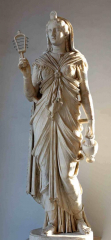 The top level of society and in particular, members of the senate, worshipped the traditional Roman gods.
The top level of society and in particular, members of the senate, worshipped the traditional Roman gods.
In 390 at the battle of the Frigidus, the Eastern Emperor Theodosius defeated the Western Emperor Eugenius in a battle whose underlying cause was the fight for the supremacy of christianity over paganism. Those supporting Christianity prevailed.
The battle inflicted disastrous losses on both sides; losses so great that Roman military capability was severely depleted.
Despite this victory, the destruction or takeover of the shrines to the ancient gods took one hundred years.
Our view of how these concepts were applied is bases in the main on information released by the inquisition and there objective was to demonise the Cathar beliefs.
Cathars did not venerate the cross. They believed that sexual pleasure was not sinful, indeed it was a gift from god to show us what pleasure union with the universal power would bring. A saying attributed to the Cathars is that ” you cannot sin below the waist’. These concepts lead to the concepts of ” Progression” when a young person was accepted as an adult and “Transition” when the young person was given instruction and practical experience of how to give and receive sexual pleasure.
Religion
 The christian world jointly referred the followers of the ancient gods “pagans” but the ihe majority of the celtic population in the countryside still worshipped the celtic gods. The Celts worshipped nature, particularly forests and water bodies, rather than gods.
The christian world jointly referred the followers of the ancient gods “pagans” but the ihe majority of the celtic population in the countryside still worshipped the celtic gods. The Celts worshipped nature, particularly forests and water bodies, rather than gods.
The Celtic religion was attacked by the Romans but eventually when the influence of the druids had been removed they accepted many aspects of the celtic beliefs, as they had done with many other religions.
 The top level of society and in particular, members of the senate, worshipped the traditional Roman gods.
The top level of society and in particular, members of the senate, worshipped the traditional Roman gods.
In 390 at the battle of the Frigidus, the Eastern Emperor Theodosius defeated the Western Emperor Eugenius in a battle whose underlying cause was the fight for the supremacy of christianity over paganism. Those supporting Christianity prevailed.
The battle inflicted disastrous losses on both sides; losses so great that Roman military capability was severely depleted.
Despite this victory, the destruction or takeover of the shrines to the ancient gods took one hundred years.
Our view of how these concepts were applied is bases in the main on information released by the inquisition and there objective was to demonise the Cathar beliefs.
Cathars did not venerate the cross. They believed that sexual pleasure was not sinful, indeed it was a gift from god to show us what pleasure union with the universal power would bring. A saying attributed to the Cathars is that ” you cannot sin below the waist’. These concepts lead to the concepts of ” Progression” when a young person was accepted as an adult and “Transition” when the young person was given instruction and practical experience of how to give and receive sexual pleasure.
 The christian world jointly referred the followers of the ancient gods “pagans” but the ihe majority of the population in the countryside still worshipped the ancient gods. They worshipped nature, particularly forests and water bodies, rather than gods.
The christian world jointly referred the followers of the ancient gods “pagans” but the ihe majority of the population in the countryside still worshipped the ancient gods. They worshipped nature, particularly forests and water bodies, rather than gods.
A feature of Celtic religion was the influence of the druids and the romans destroyed their influence but then accepted worship of the gods of nature
 this was not surprising as the Romans had always accepted the worship of gods other than teir own particularly the gods of Greece and Egypt.
this was not surprising as the Romans had always accepted the worship of gods other than teir own particularly the gods of Greece and Egypt.
The top level of society and in particular, members of the senate, worshipped a wide range of gods.
In 390 at the battle of the Frigidus, the Eastern Emperor Theodosius defeated the Western Emperor Eugenius in a battle whose underlying cause was the fight for the supremacy of christianity over paganism. Those supporting Christianity prevailed.
The battle inflicted disastrous losses on both sides; losses so great that Roman military capability was severely depleted.
Despite this victory, the destruction or takeover of the shrines to the ancient gods took more than one hundred years. The profusion of churches dedicated to the Maddona can by the fact that many of them were converted temples honouring Isis.
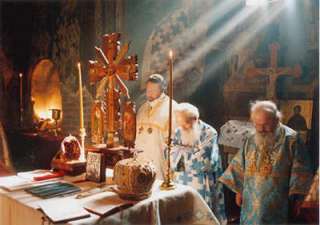
Despite the battle of Frigidus, during the latter years of the empire religion had become a preoccupation for goverment and the people.
Although Constantine had made Christianity legal and Theodosius had made it the state religion, there were many different strands of christian belief. At the time of the great migrations there were at least seven religious persuasions.
The Orthodox faith was practised in the still thriving Roman empire of the east, based in Constantinople (Byzantine Empire).
The Coptic faith was practiced in Egypt (also part of the Byzantine Empire)
The Church of Rome, which had broken away from the Orthodox church in order to seek support from the Western Emperors, propagated it’s teaching throughout Western Europe.
The Arian Church, which had been declared heretical by both the Orthodox and Roman churches, and driven from the empire, but had thrived outside the boundaries and was now being reintroduced to the empire by the migrations.
The Celtic Church was different again, so different that it sent missionaries to Europe to try and convert members of the Church of Rome to the “true faith.”
Clovis’ “Sacred” task
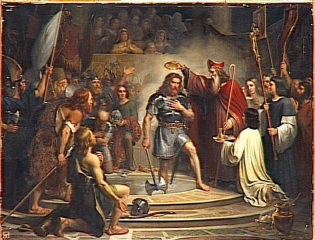 Clovis, King of the Franks, though he may have been a pagan or an arian, quite possibly both, gained enormous political advantage by aligning himself with the Church of Rome.
Clovis, King of the Franks, though he may have been a pagan or an arian, quite possibly both, gained enormous political advantage by aligning himself with the Church of Rome.
It became Clovis sacred task to conquer his Arian neighbours and impose the beliefs of the Church of Rome on them. In return for supporting his cause the Church of Rome became the administrative arm of the Frankish government.
In AD 481 when the Pope picked out a teenage troublemaker to be the temporal ruler of the Western Roman Empire, Clovis was in control of perhaps one eighth of the area in question. The rest of Europe still thought of itself as “Roman”. We know that the Roman leader in Gaul was named Syagrius but thanks to the principle that it is the victors who write history, we have no idea of his origins or indeed the role he played.
Clovis assumed or was persuaded that the Church of Rome would provide the civil administration. The role of the Dux already minimised, was phased out altogether, with bishops assuming a similar role. A cursory glance at the titles chosen for the church hierarchy shows that it closely mirrors the civil administration of the Empire.
Surprisingly but quite deliberately the church of rome took responsibility for the definition and implementation of law.
Deals were done locally between the Roman “Comes ” and the franks. In an attempt to ensure some continuity The Comes accepted a new head of state, The title Augustus was abandonned and the leader of the state became “King”.
The transition from Empire to Royames was slow, very slow. However by 481 there were eight identifyable States in Western Europe within what had been the confines of the Empire.
The Roman Republic
For the Senate and People of Rome.
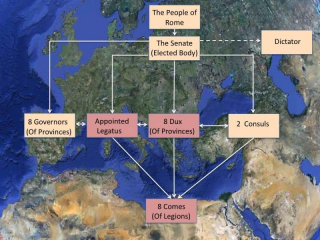
The senate, an elected body , was in control.
As the republic grew it was subdived into provinces. The objective was to retain the control.
For each Province, a “Governor” dealing with civil issues and a “Dux” dealing with military issues was appointed . bothe responded directly to the senate.
Also in every Province there was a “Comes”, in charge of a legion. The Comes responded to the Dux.
It was all about control. The senate appointed two consuls who only held power for a year. It is possible to see the Consuls as “Kings for a year” and there were deliberately two of them so one could keep check on the other,
However they often performed as trouble-shooters for the senate and were totally subject to the senates direction.
In emergencies at the discretion of the Senate, theycould appoint, for a limited time a “Dictator” who could make decisions and take action without any reference to the senate.
The Senate had another control mechanism whereby it could appoint a “Legatus” who could carry out investigations in any province. Most importantly a legatus could take command of one or more legions.
The Roman Empire
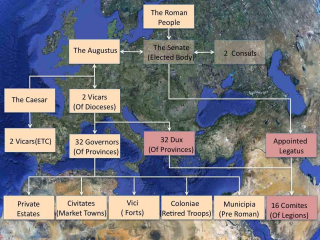 The expanding Empire was split into four “Dioceses” each one controlled by a Vicar and each Diocese was split into “Provinces”.
As the system evolved the Augustus was given a “Caesar ‘ responding to him. The Caesar had a duplicate system of Vicars, Governors etc through which he independently controlled half of the Empire. The Caesar was regarded as the “Augusta Elect” ready to take over from the Augustus when the time came.
The Empire was divided into east and west, still nominally one state, but each ruled by an Augusta and each having a Caesar in attendance.
With the passage of time the role of the senate decreased in importance. The Empire moved towards autocratic government with commands passed down the hierachy and reports transmitted upwards. The Augustus became a true dictator.
The decline in the power of the Senate was accompanied by a reduction in importance of the role of the Legate. This resulted in greater autonomy being given to the Governors, Dux and local client Kings. As concepts of Empire evolved extensive use was made of Client Kings. As long as unity of the Empire and its commercial needs were honoured, individual Kings were given a surprising level of freedom.The empire was in itself a metamorphosis from the republic. As the republic continued to grow the complex system needed a strong hand to ensure that individual public officials did not put their own interests ahead of those of the State.
The expanding Empire was split into four “Dioceses” each one controlled by a Vicar and each Diocese was split into “Provinces”.
As the system evolved the Augustus was given a “Caesar ‘ responding to him. The Caesar had a duplicate system of Vicars, Governors etc through which he independently controlled half of the Empire. The Caesar was regarded as the “Augusta Elect” ready to take over from the Augustus when the time came.
The Empire was divided into east and west, still nominally one state, but each ruled by an Augusta and each having a Caesar in attendance.
With the passage of time the role of the senate decreased in importance. The Empire moved towards autocratic government with commands passed down the hierachy and reports transmitted upwards. The Augustus became a true dictator.
The decline in the power of the Senate was accompanied by a reduction in importance of the role of the Legate. This resulted in greater autonomy being given to the Governors, Dux and local client Kings. As concepts of Empire evolved extensive use was made of Client Kings. As long as unity of the Empire and its commercial needs were honoured, individual Kings were given a surprising level of freedom.The empire was in itself a metamorphosis from the republic. As the republic continued to grow the complex system needed a strong hand to ensure that individual public officials did not put their own interests ahead of those of the State.
Initially the Augustus was simply a dictator appointed for life. The system became used to this way of working or was forced to adopt it by political processes and the concept of Augustus prevailed beyond the “fall”
Eventually the expanding Empire was split into four “Dioceses” each one controlled by a Vicar and each Diocese covered several Provinces.
The Principiate
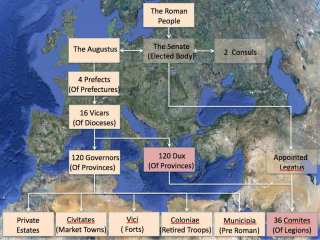 As the Empire grew larger, the administration continued to evolve. Four Pretarorian Prefects were appointed to assist with Co-ordination between Vicars. However events beyond the empire and new tactics and technology used by barbarian armies demanded even further reform.The empire expanded rapidly. The Augustus was given a “Caesar” responding to him. The Caesar had a duplicate system of Vicars, Governors etc through which he independently controlled half of the Empire. The Caesar was regarded as the “Augusta Elect” ready to take over from the Augustus when the time came. The Empire was eventually divided still further into east and west, still nominally one state, but each ruled by an Augusta and each having a Caesar in attendance.
As the Empire grew larger, the administration continued to evolve. Four Pretarorian Prefects were appointed to assist with Co-ordination between Vicars. However events beyond the empire and new tactics and technology used by barbarian armies demanded even further reform.The empire expanded rapidly. The Augustus was given a “Caesar” responding to him. The Caesar had a duplicate system of Vicars, Governors etc through which he independently controlled half of the Empire. The Caesar was regarded as the “Augusta Elect” ready to take over from the Augustus when the time came. The Empire was eventually divided still further into east and west, still nominally one state, but each ruled by an Augusta and each having a Caesar in attendance.
With the passage of time the role of the senate decreased in importance. The decline in the power of the Senate was accompanied by a reduction in importance of the role of the Legate. The evolution continued. Four Pretorian Prefects were appointed to assist co-ordination between Vicars.
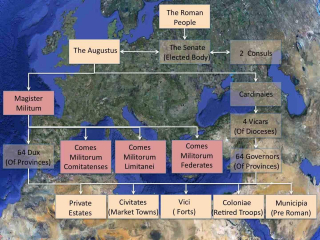 The strategy being used depended totally on local quick decision making. The Comitas were detached from the Dux and given the authority to command not only their troops but civil and other military personnel. Whole districts were put under their command. The organisation created occasional conflict Comitas and Magister Milatorum.
For all this to work the district civil administration had to understand the role of the Comitas and the role the civil population must play. The Comitas became increasingly independent and self reliant in the area they controlled.However events beyond the empire and increasing conflict with barbarian armies ultimately demanded even further reform. Note the fleeting appearance of the “Cardinales” who not only co-ordinated the Vicars but was responsible for their activities. However the role of military forces was enhanced, they responded directly to the Augustus and took a steadily increasing interest in civil administration. The Empire slowly became a military state. This was facilitated by the appointment of a “Magister Militorum”.
The strategy being used depended totally on local quick decision making. The Comitas were detached from the Dux and given the authority to command not only their troops but civil and other military personnel. Whole districts were put under their command. The organisation created occasional conflict Comitas and Magister Milatorum.
For all this to work the district civil administration had to understand the role of the Comitas and the role the civil population must play. The Comitas became increasingly independent and self reliant in the area they controlled.However events beyond the empire and increasing conflict with barbarian armies ultimately demanded even further reform. Note the fleeting appearance of the “Cardinales” who not only co-ordinated the Vicars but was responsible for their activities. However the role of military forces was enhanced, they responded directly to the Augustus and took a steadily increasing interest in civil administration. The Empire slowly became a military state. This was facilitated by the appointment of a “Magister Militorum”.
The strategy being used depended totally on locally based quick decision making. The Comitas were given the authority to command not only their troops but civil and other military personnel. Whole districts were put under their command. They became independent of the Dux who took over administrative duties but now responded to the Magister Militum.
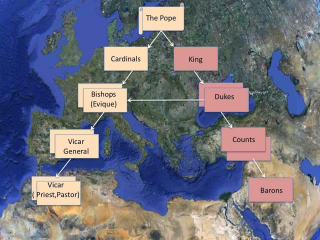 The Pope of the time developed the concept of right to rule. He maintained that Roman Emperor Constantine the Great had given the Popes of Rome the right to the temporal rule of the Western Empire. This was ultimately supported by documentation known as the “Donation of Constantine” (which much later was proved to be one of the greatest forgeries and therefore frauds, of all time). Nevertheless the Pope used this concept to intervene and appoint the untrustworthy devious, murderous, teenage leader of the Frankish tribe to be his Magister Militarum. A cursory examination of the titles chosen for the new Church of Rome hierachy shows that it was the Church itself which was intended to provide the civil governance.
The leader of the Franks was called Clovis and the Dynasty he founded the Merovingians.
There are many legends about why the Pope, chose Clovis, but it was really because he permitted the Church of Rome to adopt, at least in the short term, the role it had assigned to itself - to become the spiritual and temporal ruler of the Western Empire. Clovis became the classic Client King. His job was simply to use his ruthless political and military skills to eliminate the opposition, which he did, with brutal efficiency.The Comes began to organise themselves locally for their own defence. They became totally independent and self reliant in the area they controlled. These Comes were the Local “lords” who ultimately chose to swear allegiance to Clovis. They retained however a great measure of their independence. They became the “Comtes” of the medieval world.
The Pope of the time developed the concept of right to rule. He maintained that Roman Emperor Constantine the Great had given the Popes of Rome the right to the temporal rule of the Western Empire. This was ultimately supported by documentation known as the “Donation of Constantine” (which much later was proved to be one of the greatest forgeries and therefore frauds, of all time). Nevertheless the Pope used this concept to intervene and appoint the untrustworthy devious, murderous, teenage leader of the Frankish tribe to be his Magister Militarum. A cursory examination of the titles chosen for the new Church of Rome hierachy shows that it was the Church itself which was intended to provide the civil governance.
The leader of the Franks was called Clovis and the Dynasty he founded the Merovingians.
There are many legends about why the Pope, chose Clovis, but it was really because he permitted the Church of Rome to adopt, at least in the short term, the role it had assigned to itself - to become the spiritual and temporal ruler of the Western Empire. Clovis became the classic Client King. His job was simply to use his ruthless political and military skills to eliminate the opposition, which he did, with brutal efficiency.The Comes began to organise themselves locally for their own defence. They became totally independent and self reliant in the area they controlled. These Comes were the Local “lords” who ultimately chose to swear allegiance to Clovis. They retained however a great measure of their independence. They became the “Comtes” of the medieval world.
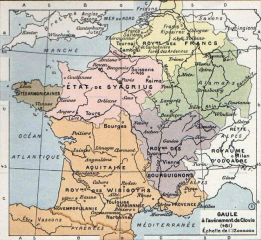 At the time the Pope appointed Clovis as the chosen one, remnants of the Roman Empire still existed in Northern Gaul and Western Britain. The roman leader in Gaul we know was named Syagrius but thanks to the principle that it is the victors write history, we have no idea what role he played. Some British records say that his contemporary in England was named Arthur but we know even less about him.
The Francs, Alamans and Burgundians had assumed control in different parts of the Empire and redistributed much of the land to their own tribe. Obviously those who had lost their land would bear resentment. Strong control and the imposition and enforcement of laws to protect the rule of the new regime were necessary.
In the Gothic territories the Roman system still applied. The Gothic families took the place of the patricians, the aristocratic Roman Families, but made themselves rich in the same way the Roman Families had done, from the proceeds of holding public office.
Clovis defeated both Alamans, Sygarius and the Visigoths in just four battles. He failed to defeat the Burgundians and formed a temporary alliance with them to defeat the Visigoths. Only the battle against the Alamans seems to have been bitterly contested. Particularly in the case of the Visigoths the Visigothic army changed sides or “melted away”. What Clovis was careful to do was murder the leader of the opposite side.
In the case of the Alamans therefore the Comptes simply had to switch their allegiance to Clovis. However for both the remnant of Syagrius’ domain (to become Normandy and Anjou)and the Visigothic lands(to become Aquitaine), Clovis was able to offer an unexpected bonus to the Comptes in those territories. In a deal brokered by the Church of Rome the comptes were allowed to keep their lands and were allowed to claim all taxes and revenue from trading from those lands, as long as they delivered what they had promised to Clovis in terms of financial and military support. They could keep the balance for themselves. Freed from the machinations of Roman Government they were left with increased power and an higher income.
Not surprisingly the Comptes swore allegiance to Clovis. It was like instant Empire.
The Dukes however were generally replaced by members of Clovis own family., thus setting another practice which lasted for over five hundred years, that Dukes must be a member of the royal family.
What was lost was the law giving and enforcement of the roman state. This was replaced locally and in a relatively primitive manor.
At the time the Pope appointed Clovis as the chosen one, remnants of the Roman Empire still existed in Northern Gaul and Western Britain. The roman leader in Gaul we know was named Syagrius but thanks to the principle that it is the victors write history, we have no idea what role he played. Some British records say that his contemporary in England was named Arthur but we know even less about him.
The Francs, Alamans and Burgundians had assumed control in different parts of the Empire and redistributed much of the land to their own tribe. Obviously those who had lost their land would bear resentment. Strong control and the imposition and enforcement of laws to protect the rule of the new regime were necessary.
In the Gothic territories the Roman system still applied. The Gothic families took the place of the patricians, the aristocratic Roman Families, but made themselves rich in the same way the Roman Families had done, from the proceeds of holding public office.
Clovis defeated both Alamans, Sygarius and the Visigoths in just four battles. He failed to defeat the Burgundians and formed a temporary alliance with them to defeat the Visigoths. Only the battle against the Alamans seems to have been bitterly contested. Particularly in the case of the Visigoths the Visigothic army changed sides or “melted away”. What Clovis was careful to do was murder the leader of the opposite side.
In the case of the Alamans therefore the Comptes simply had to switch their allegiance to Clovis. However for both the remnant of Syagrius’ domain (to become Normandy and Anjou)and the Visigothic lands(to become Aquitaine), Clovis was able to offer an unexpected bonus to the Comptes in those territories. In a deal brokered by the Church of Rome the comptes were allowed to keep their lands and were allowed to claim all taxes and revenue from trading from those lands, as long as they delivered what they had promised to Clovis in terms of financial and military support. They could keep the balance for themselves. Freed from the machinations of Roman Government they were left with increased power and an higher income.
Not surprisingly the Comptes swore allegiance to Clovis. It was like instant Empire.
The Dukes however were generally replaced by members of Clovis own family., thus setting another practice which lasted for over five hundred years, that Dukes must be a member of the royal family.
What was lost was the law giving and enforcement of the roman state. This was replaced locally and in a relatively primitive manor.
 At the time the Pope appointed Clovis as the chosen one, remnants of the Roman Empire still existed in Northern Gaul and Western Britain. The roman leader in Gaul we know was named Syagrius but thanks to the principle that it is the victors write history, we have no idea what role he played. Some British records say that his contemporary in England was named Arthur but we know even less about him.
The Francs, Alamans and Burgundians had assumed control in different parts of the Empire and redistributed much of the land to their own tribe. Obviously those who had lost their land would bear resentment. Strong control and the imposition and enforcement of laws to protect the rule of the new regime were necessary.
In the Gothic territories the Roman system still applied. The Gothic families took the place of the patricians, the aristocratic Roman Families, but made themselves rich in the same way the Roman Families had done, from the proceeds of holding public office.
Clovis defeated both Alamans, Sygarius and the Visigoths in just four battles. He failed to defeat the Burgundians and formed a temporary alliance with them to defeat the Visigoths. Only the battle against the Alamans seems to have been bitterly contested. Particularly in the case of the Visigoths the Visigothic army changed sides or “melted away”. What Clovis was careful to do was murder the leader of the opposite side.
In the case of the Alamans therefore the Comptes simply had to switch their allegiance to Clovis. However for both the remnant of Syagrius’ domain (to become Normandy and Anjou)and the Visigothic lands(to become Aquitaine), Clovis was able to offer an unexpected bonus to the Comptes in those territories. In a deal brokered by the Church of Rome the comptes were allowed to keep their lands and were allowed to claim all taxes and revenue from trading from those lands, as long as they delivered what they had promised to Clovis in terms of financial and military support. They could keep the balance for themselves. Freed from the machinations of Roman Government they were left with increased power and an higher income.
Not surprisingly the Comptes swore allegiance to Clovis. It was like instant Empire.
The Dukes however were generally replaced by members of Clovis own family., thus setting another practice which lasted for over five hundred years, that Dukes must be a member of the royal family.
What was lost was the law giving and enforcement of the roman state. This was replaced locally and in a relatively primitive manor.
At the time the Pope appointed Clovis as the chosen one, remnants of the Roman Empire still existed in Northern Gaul and Western Britain. The roman leader in Gaul we know was named Syagrius but thanks to the principle that it is the victors write history, we have no idea what role he played. Some British records say that his contemporary in England was named Arthur but we know even less about him.
The Francs, Alamans and Burgundians had assumed control in different parts of the Empire and redistributed much of the land to their own tribe. Obviously those who had lost their land would bear resentment. Strong control and the imposition and enforcement of laws to protect the rule of the new regime were necessary.
In the Gothic territories the Roman system still applied. The Gothic families took the place of the patricians, the aristocratic Roman Families, but made themselves rich in the same way the Roman Families had done, from the proceeds of holding public office.
Clovis defeated both Alamans, Sygarius and the Visigoths in just four battles. He failed to defeat the Burgundians and formed a temporary alliance with them to defeat the Visigoths. Only the battle against the Alamans seems to have been bitterly contested. Particularly in the case of the Visigoths the Visigothic army changed sides or “melted away”. What Clovis was careful to do was murder the leader of the opposite side.
In the case of the Alamans therefore the Comptes simply had to switch their allegiance to Clovis. However for both the remnant of Syagrius’ domain (to become Normandy and Anjou)and the Visigothic lands(to become Aquitaine), Clovis was able to offer an unexpected bonus to the Comptes in those territories. In a deal brokered by the Church of Rome the comptes were allowed to keep their lands and were allowed to claim all taxes and revenue from trading from those lands, as long as they delivered what they had promised to Clovis in terms of financial and military support. They could keep the balance for themselves. Freed from the machinations of Roman Government they were left with increased power and an higher income.
Not surprisingly the Comptes swore allegiance to Clovis. It was like instant Empire.
The Dukes however were generally replaced by members of Clovis own family., thus setting another practice which lasted for over five hundred years, that Dukes must be a member of the royal family.
What was lost was the law giving and enforcement of the roman state. This was replaced locally and in a relatively primitive manor.
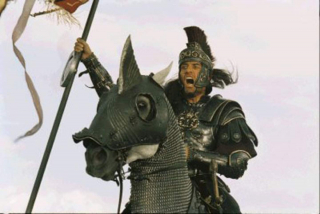 Some British records say that his Roman contemporary in England was named Arthur, but we know even less about him. What these two leaders had in common was that they did not accept the rule of Odoacer. who had deposed the last Emperor of the West, Romulus Augustus. The older histories (Geoffery of Monmouth) identifies a joint campaign between Syagrius and Arthur against Odoacer, who declared himself to be acting on behalf of Zeno, Emperor of the Eastern Roman Empire.
Some British records say that his Roman contemporary in England was named Arthur, but we know even less about him. What these two leaders had in common was that they did not accept the rule of Odoacer. who had deposed the last Emperor of the West, Romulus Augustus. The older histories (Geoffery of Monmouth) identifies a joint campaign between Syagrius and Arthur against Odoacer, who declared himself to be acting on behalf of Zeno, Emperor of the Eastern Roman Empire.
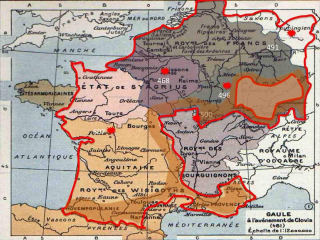 The feudal system had a fatal flaw, however. It relied on the oath of Allegiance and allegiances can be changed. By his failure to fully conquor either the Alamans or the Burgundians, plus interfaces with Vascon, Breton and Visigothic lands Clovis had created an Empire which had literally thousands of miles of border territories. These became known as marcher territories.
They were areas in which the comptes were exposed to risk of attack across the border but also able to negotiate for better terms.
The feudal system had a fatal flaw, however. It relied on the oath of Allegiance and allegiances can be changed. By his failure to fully conquor either the Alamans or the Burgundians, plus interfaces with Vascon, Breton and Visigothic lands Clovis had created an Empire which had literally thousands of miles of border territories. These became known as marcher territories.
They were areas in which the comptes were exposed to risk of attack across the border but also able to negotiate for better terms.
Clovis was able to the provide the lords of the lands he now controlled an unexpected bonus. In a deal brokered by the Church of Rome the local landowners were allowed to keep their lands and were allowed to claim all taxes and revenue from trading from those lands, as long as they delivered what Clovis demanded in terms of financial and military support. The feudal system was born.
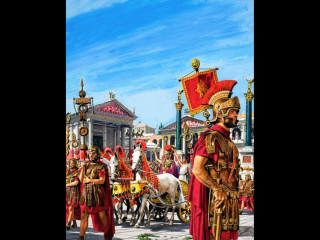 The recent (2011) discovery of 50 decapitated bodies near Maiden Castle in Dorset, England serves as a good reminder that the Pax Romana was peace for the Roman people, not necessarily for anyone else. The bodies have beed carbon dated to be victims of the Roman invasion of Britain in AD 43. From both Sygerius and the Visigoths Clovis inherited an essentially Roman administration, in some ways unchanged from the early days of the republic. The Roman system of government was complex. The whole objective was to provide wealth for Roman Citizens. There were thousands upon thousands of Roman Officials. It was not so much an administration as a means of wealth distribution. Wealth, generated by the Empire, was distributed to Roman Citizens by payment for performing public office and at the lower levels for services provided to public officials. Along with payment, all public offices offered the opportunity to take a commission on transactions under the incumbent’s control or even from a specific sphere of influence.
The recent (2011) discovery of 50 decapitated bodies near Maiden Castle in Dorset, England serves as a good reminder that the Pax Romana was peace for the Roman people, not necessarily for anyone else. The bodies have beed carbon dated to be victims of the Roman invasion of Britain in AD 43. From both Sygerius and the Visigoths Clovis inherited an essentially Roman administration, in some ways unchanged from the early days of the republic. The Roman system of government was complex. The whole objective was to provide wealth for Roman Citizens. There were thousands upon thousands of Roman Officials. It was not so much an administration as a means of wealth distribution. Wealth, generated by the Empire, was distributed to Roman Citizens by payment for performing public office and at the lower levels for services provided to public officials. Along with payment, all public offices offered the opportunity to take a commission on transactions under the incumbent’s control or even from a specific sphere of influence.
